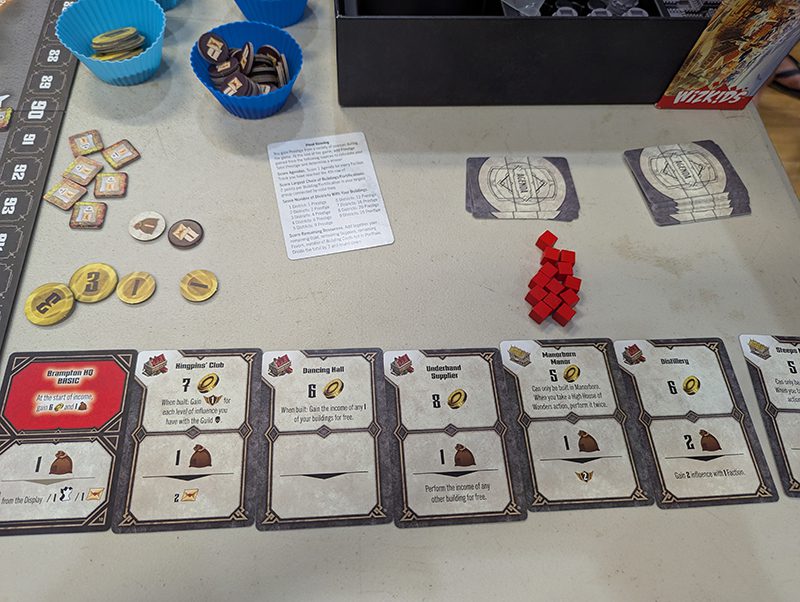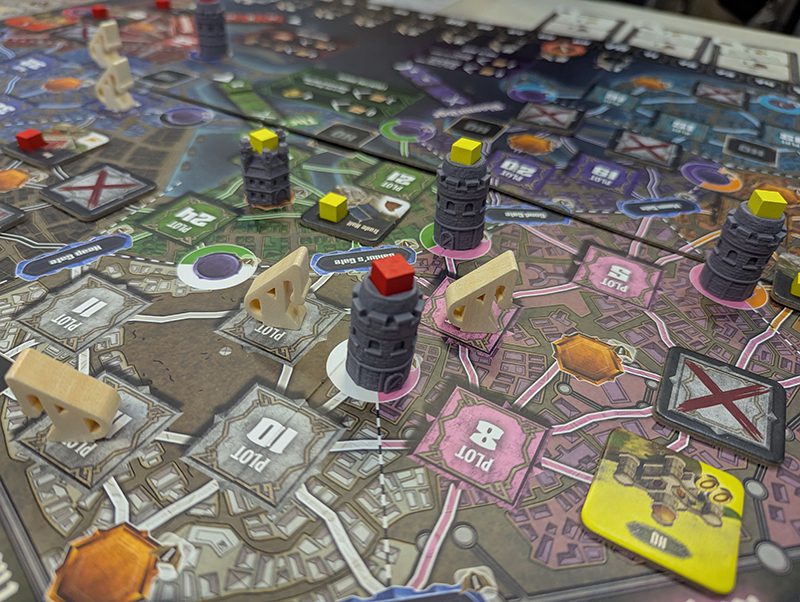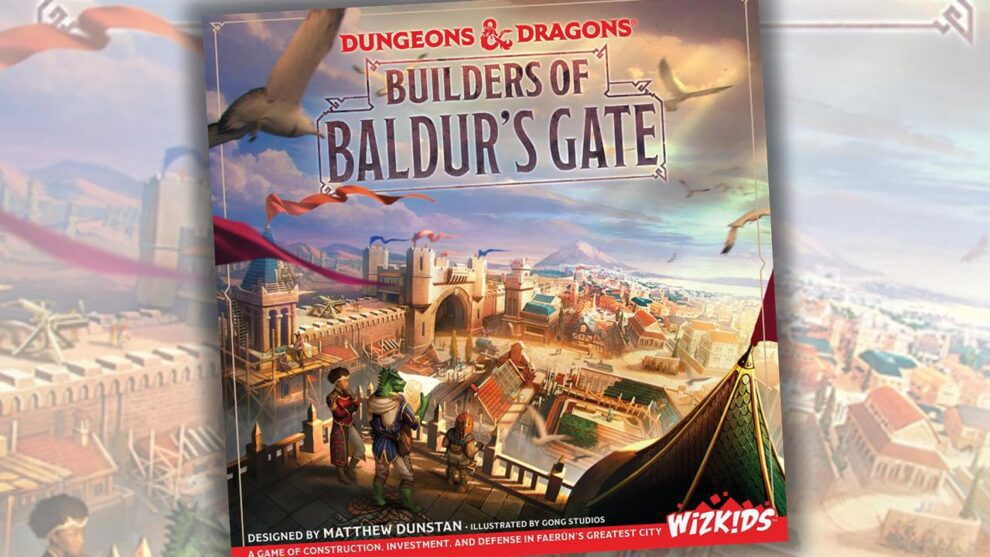Disclosure: Meeple Mountain received a free copy of this product in exchange for an honest, unbiased review. This review is not intended to be an endorsement.
When you hear “Dungeons & Dragons,” you expect tales of scrappy adventurers delving into dark dungeons and earning their fortune through perilous quests. Builders of Baldur’s Gate throws that entire fantasy out the window. Instead of playing humble heroes rising from nothing, you’re wealthy nobles and powerful families who already sit atop mountains of gold, focused on expanding your influence through economic maneuvering and shrewd building placement. It is a game that trades sword and sorcery for city planning and arithmetic math.
So yes, this is yet another European-style board game draped in Dungeons & Dragons colors. Like countless other euros, it features the familiar mechanics of worker placement, special ability cards, and resource constraints to navigate. With Baldur’s Gate name prominently displayed on the box, the game naturally included the obligatory “city under siege” element where players contribute to its defense. And true to euro form, your success isn’t measured in epic tales or heroic deeds, but in the cold calculation of victory points.

Trading Swords for Spreadsheets
With the theme overview out of the way, let’s talk about mechanisms.
You start out with a handful of building cards, agenda cards, some coins, favor, and supplies. Favor acts as the currency for the worker placement part of the game, and you only have one worker. Your building cards represent opportunities to place down your buildings that might give you income opportunities or special abilities. To fuel those building opportunities, you need supplies to spend.
Another detail to consider is the faction tracks representing the different power groups in Baldur’s Gate. There are three factions, and as you take worker placement actions throughout the game, you’ll advance up these tracks to gain additional resources and points. Your position on these faction tracks is extremely important because it determines whether you can score your end-game agenda cards. You cannot use those agenda cards without reaching certain levels with each faction.
A Different Kind of Fantasy
The board itself represents the city map divided into districts with four plots each and several places to plant fortifications such as gates, watchtowers, and keeps. There will always be 8 plots available, representing opportunities to place a building. Each time a building is made, another plot is available via drawing a tile from the bag. This doesn’t just represent the available plot, but also the increasing threat of that district being under attack. Over the course of the game, each district faces exactly one attack, and after all districts have been targeted, the game ends.
As for your turn, pick one of three actions, do it, and you’re done. The first one is placing your sole worker in a worker placement spot. Each spot has a “free action” and one that costs favor resources for a bigger payout. It’s your usual affair of actions such as allowing you to place fortifications, get some coin, or moving up on a faction track. The minor twist here is you can go to a spot with another player’s worker, and that player’s worker simply goes back to them. Otherwise, the only way to get your worker back is through a Collect Income action.
The Collect Income action works as expected. You gain 6 coins and 1 supply resource as your base income. You can also activate building cards in your portfolio. Each time you construct a building on the board, you add the corresponding building card to your collection. These cards often provide special abilities or allow you to convert your supply resources into other benefits, such as victory points or moving up on the faction track. While this system initially suggests the potential for powerful card combinations and engine-building, the actual implementation has significant limitations that prevent it from reaching its potential, but more on that later.

Welcome to Bureaucracy Gate
The final and third action you can take is building. This is, perhaps, the most “complicated” part of the game. Simply pay the cost of your building card and place the building card from your tableau. From there, you place your building tile in one of the 8 available plots. This is important because where you place buildings impacts the neighboring buildings and fortifications. Whenever someone places a building, owners of adjacent properties get resources or victory point depending on the building type. Any worker in that area also goes back to the player’s pool, ready to be used again.
After the building is placed and resources are paid out, you pull a tile from the bag that shows the next available plot as well as a potential attack.
When an attack happens, the resolution is straightforward. All players know the attack’s strength in advance, but the target district remains unknown until revealed. Each district’s defense value comes from any fortifications built there. You compare the district’s total defense against the attack strength. If the defense meets or exceeds the attack, players who contributed fortifications to that district earn points, with the player who contributed the most receiving double points.
However, if the attack strength exceeds the defense, players who didn’t contribute fortifications to that district lose their buildings there and the worker placement costs increase for everyone. Since end-game scoring rewards both the number of districts you occupy and your largest connected network of buildings, a successful attack can significantly impact your final score by reducing your territorial presence. This attack system is the muscle of the game’s strategic tension, forcing players to balance expansion with defense throughout the entire experience.
The Silver Lining
While the game presents itself as a tight euro with meaningful decisions, the reality is far more frustrating than fulfilling. Before I go into the negatives, I want to talk about what I do like here.
The random plot system that also signals upcoming attacks is actually pretty clever. It’s easy to understand and creates real stress when someone announces they’re about to build. There’s a nice thematic touch too; the idea that bureaucratic red tape controls how a city grows feels spot-on. Just look at California if you want to see this concept in action.
The scoring system for city defense works well too. As attack strength ramps up with each siege, players are always fighting over those Watchtowers and Keeps to grab bonus points while protecting their investments. It fits the theme nicely of wealthy nobles doing “charitable” work that just happens to benefit their own interests.
Sadly, that’s about where the good stuff ends. And much like California, the biggest issue with Builders of Baldur’s Gate is its broken economy.
A few things you will learn very quickly is gold is plentiful, favor is reasonable, and supplies are too scarce. You’ll spend a good portion of the early phase of the game constantly collecting income because there is hardly any other way to get resources. You’ll often send your worker to collect your resources, use your gold to build, then collect income to get that worker back. If the buildings in your hand are too expensive, you might have to do back-to-back collect income phases.
While this doesn’t sound too bad, it means every game starts out the same with little variation between sessions. This isn’t SETI or Terraforming Mars here with you scrutinizing your hand . Since you are collecting income constantly, you’ll find that gold becomes plentiful, therefore the choice of what building to build from your hand becomes rather moot as you merely place down a building for the sake of placing down the building.

Starvation Economics
Getting favor resources is reasonable as you often get them from your buildings or other worker placement spots. You will definitely need them because not only do they allow you to move up the faction tracks faster, you also get opportunities to build defenses for those extra points. It’s one of the few areas that work.
The biggest problem is the supply resource. For whatever reason, Builders of Baldur’s Gate is asking you to pull teeth from Tiamat’s mouth just to get a decent number of them. It is, by far, the most important resource in the entire game and not because of its strength, but rather what allows you to do so.
Every Collect Income action gives you 6 gold and exactly 1 supply resource. Your starting card lets you spend that single supply to draw building cards, gain favor, or retrieve your worker. Meanwhile, most building cards demand multiple supply resources to activate their powers such as victory points, moving up the faction track, or gaining favor resources. See the problem? You’re perpetually starved for supply, forcing you to waste turns on the bland default action instead of engaging with your cards. The game teases you with an enticing array of building abilities, then withholds the resources needed to actually use them.
It’s teeth sucking frustration.
The Resource Chokehold
“What about those adjacency bonuses from neighboring buildings?” you might ask. Sure, except the available plots are randomly drawn, so those opportunities aren’t guaranteed. You can build Gates that provide extra worker placement actions, but naturally, those also require supply resources to activate.
That’s the core problem right there. Builders of Baldur’s Gate dangles all these interesting systems in front of you, then chokes them with resource constraints so tight they suffocate the life out of the game. There are building cards that give you supply resources, but they are extremely rare.
The presentation doesn’t help matters either. For a city-building game with tower defense elements with the Dungeons & Dragons stamped on its forehead, it feels remarkably generic. The enemies attacking your city don’t even have names. Building cards use bland templates with basic fonts and no unique artwork to distinguish them. The three factions are supposedly based on actual D&D organizations, but they’re reduced to abstract logos with zero personality. Even the worker placement spots are just text boxes. One references a “Boo & Minsc” statue but doesn’t bother showing you what it actually looks like.
The frustrating thing is that the physical components are actually solid. There’s genuine satisfaction in watching the flat city board come alive as players add towers, gates, and buildings across the districts.
What Could Have Been
Builders of Baldur’s Gate feels like a missed opportunity wrapped in solid components and decent ideas. The attack system shows glimpses of clever design, creating genuine tension and meaningful decisions around risk and reward. The random plot revelation is intuitive and thematically sound. Even the concept of playing wealthy nobles rather than scrappy adventurers could have been a refreshing take on the D&D universe.
Instead, we’re left with a game that teases engaging systems but refuses to let you actually engage with them. Builders of Baldur’s Gate has the bones of something good, but the execution leaves you wishing they had spent more time fine-tuning the economic balance.












